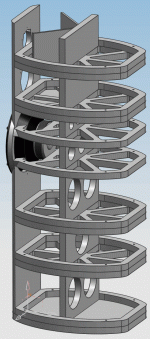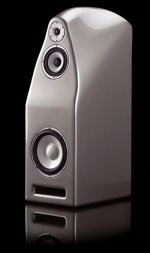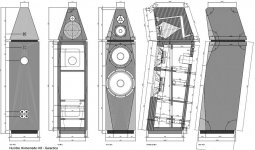That was a lot more than I thought! Lowering it a few centimeters made a lot of difference. The only question is baffle width - should I use the actual baffle width, or compensate for the rounded edges? They're 40 mm radius, so they should have some effect, right?
That was a lot more than I thought! Lowering it a few centimeters made a lot of difference. The only question is baffle width - should I use the actual baffle width, or compensate for the rounded edges? They're 40 mm radius, so they should have some effect, right?
Probably some but hard to predict exactly. Try 1/3rd of the way to the edge from the start of the radius.
If you find dimensions that work well with hard edges then the radius will only make things better.
David S.
Sorry, got things a bit confused... The strange thing is that, taking listening position into consideration, the current tweeter position is by far the best from about 5 kHz, and down to below crossover frequency it has one dip and one peak that should be very manageable for digital filters. Shouldn't be too hard to make a passive crossover either, if I should ever feel the need.
The Olsen paper needs to be read with a grain of salt. The baffle sizes shown WRT the graphs are not small for a real world implementation where you want those curves...
Imo, you'd be better off turning the cabinet 90 degrees and mounting the speakers as flush
as possible on the wider side... far better.
_-_-bear
Imo, you'd be better off turning the cabinet 90 degrees and mounting the speakers as flush
as possible on the wider side... far better.
_-_-bear
I'm attaching a render of the internal workings. The lower braces are self explanatory. The middle ones have an added crossmember for bracing the woofer magnet. The two upper ones have partial floors and walls to create separate enclosures for mid and tweeter (I'm using a Vifa XT25 without rear chamber).
In a translam like you are proposing, i strongly suspect that each brace is only effective for the slice it is built into. Make the braces separately and run them vertically so that they brace all the pieces.
dave
I'll be running digital crossovers and room correction/equalizing on a dedicated PC, so it'll be relatively simple to correct for baffle step an all that, but internal reflections are still a bad thing...
Comments?
what software will you be using for the X-over and music playback?
planet10: The slices will be firmly glued together, so the braces should work for the whole structure. I saw a stupendously expensive speaker being made this way, but I don't remember what it was at the moment. But it's simple as pie to add some more bracing in between there. Mmmm, pie...
One very material-saving alternative to the full sandwich is to simply cut the side arches for each side and glue it onto the other walls and internal braces like a regular enclosure, but that could lose a lot of stiffness. And it would add the human inaccuracy factor, which in my case it rather terrifying 🙂
CCU: Don't know yet. I'll have plenty of time to contemplate on that while making DACs and amps.
One very material-saving alternative to the full sandwich is to simply cut the side arches for each side and glue it onto the other walls and internal braces like a regular enclosure, but that could lose a lot of stiffness. And it would add the human inaccuracy factor, which in my case it rather terrifying 🙂
CCU: Don't know yet. I'll have plenty of time to contemplate on that while making DACs and amps.
Last edited:
planet10: The slices will be firmly glued together, so the braces should work for the whole structure. I saw a stupendously expensive speaker being made this way, but I don't remember what it was at the moment.
Magico. I've seen too many of these kinds of boxes split in a slice to believe that that bracing scheme is effective as possible -- it certainly isn't in a conventionally built box.
dave
Point taken. I've added sideways braces, but I gotta admit it might be just as well to skip the whole slice braces and go for a matrix like bracing with thinner plates. Then it should be good enough to cut out the sides as separate arcs, too. Would work wonders for material waste.
Attachments
A couple of questions:
What are these going to be cut from? MDF?
What outside finish are you planning? Paint, veneer?
What are these going to be cut from? MDF?
What outside finish are you planning? Paint, veneer?
It's all 22 mm MDF. I'll cover it with veneer, probably cherry.
I read about some company that cut slits along the length of a sheet of MDF to bend it to any shape, but I don't know how doable that is in DIY, and how smooth the bend will be. It might be a lot easier than cutting and gluing each section, but if it leaves a bumpy surface, it ain't good enough.
I read about some company that cut slits along the length of a sheet of MDF to bend it to any shape, but I don't know how doable that is in DIY, and how smooth the bend will be. It might be a lot easier than cutting and gluing each section, but if it leaves a bumpy surface, it ain't good enough.
It might be a lot easier than cutting and gluing each section, but if it leaves a bumpy surface, it ain't good enough.
If you use thinner pieces (1/8" to 1/4" thick) in layers and are careful, it can be a lot better and you will get a much smoother surface. The problems arise when you want to join the corners, top and bottom but it is doable.
The stacked lamination method leaves a LOT of edge grain exposed and this is very receptive to moisture (swelling and then shrinkage). Also, to try and limit the amount of moisture absorbed, you will want to thoroughly seal the inside of the cabinet.
To guard against cold creep on the glue joints, you'll want to use plastic resin glue or polyurethane. Regular wood glue is best avoided if you can't get massive clamp pressure on the parts. Veneer will cover a lot of cold creep but the best strategy is to try to minimize it in the first place.
Last edited:
Hi novec,
I attached a few pictures for discussion. B&W Diamond series uses a physical shape similar to your first drawing. Picture 2 shows a DIY with similar shape. Hansen speakers in picture 3 attempt to manage both time alignment and edge diffraction.
I attached a few pictures for discussion. B&W Diamond series uses a physical shape similar to your first drawing. Picture 2 shows a DIY with similar shape. Hansen speakers in picture 3 attempt to manage both time alignment and edge diffraction.
Attachments
So if I'd only lost the extra baffle, I would have been a genious 😀
Thanks for the tips, John. I'll stay away from the bendy wood, but I definitely have some things to learn from you when it comes to wood working. Your speakers are truly beautiful!
Thanks for the tips, John. I'll stay away from the bendy wood, but I definitely have some things to learn from you when it comes to wood working. Your speakers are truly beautiful!
Hi novec,
I attached a few more pictures for discussion. Humble Home HiFi developed the Galactica which uses the truncated pyramid to reduce diffraction, and later built the mezzo glactica with a sliced pear shape as a simpler 3-way. The truncated pyramid seems popular as it simulates well in EDGE just as expected from Olson's book.
I attached a few more pictures for discussion. Humble Home HiFi developed the Galactica which uses the truncated pyramid to reduce diffraction, and later built the mezzo glactica with a sliced pear shape as a simpler 3-way. The truncated pyramid seems popular as it simulates well in EDGE just as expected from Olson's book.
Attachments
Some of those cabinet examples, even though they are very exotic and expensive shapes, would be very bad for diffraction related frequency response.
The truncated pear shape, for example, puts a hard ridge around the tweeter in very nearly a concentric circle. This guarantees a strong time coherent reflection for big response nulls. Same with the first group of 3, two of them have raised lips encircling the tweeter.
B&W has popularized the "salt shaker on top" tweeter mounting. Has anybody measured one? Not good, due to cabinet top reflections and totally circular mounting bezel.
These are typical of high end audio today: Designed by the marketing department to look exotic, performance is secondary.
David S.
The truncated pear shape, for example, puts a hard ridge around the tweeter in very nearly a concentric circle. This guarantees a strong time coherent reflection for big response nulls. Same with the first group of 3, two of them have raised lips encircling the tweeter.
B&W has popularized the "salt shaker on top" tweeter mounting. Has anybody measured one? Not good, due to cabinet top reflections and totally circular mounting bezel.
These are typical of high end audio today: Designed by the marketing department to look exotic, performance is secondary.
David S.
Thanks for the tips, John. I'll stay away from the bendy wood, but I definitely have some things to learn from you when it comes to wood working. Your speakers are truly beautiful!
Thanks! 🙂
I think the reflection/diffraction issue is blown way out of proportion. Certainly none of the examples shown above will sound bad due to it (possible exception is that first white one, that looks like Beaker from the Muppets). Totem Acoustic built speakers with 90 degree baffle to side/top for years. They only recently changed to a slight chamfer at 45 degrees. Last I heard, these are highly regarded speakers.
Chasing the elusive target of sonic perfection is fine but getting strung out on what could possibly be a very minor detail is not productive. Building something that sounds good is fantastic. Building something that LOOKS fantastic is as good, if not better - considering that about 99% of the population (includes your family and friends) don't really care about how amazing the speakers sound but you will get boat-loads of praise if they look good.
Last edited:
- Status
- Not open for further replies.
- Home
- Loudspeakers
- Multi-Way
- Elliptical enclosure - reflection/diffraction issues?






